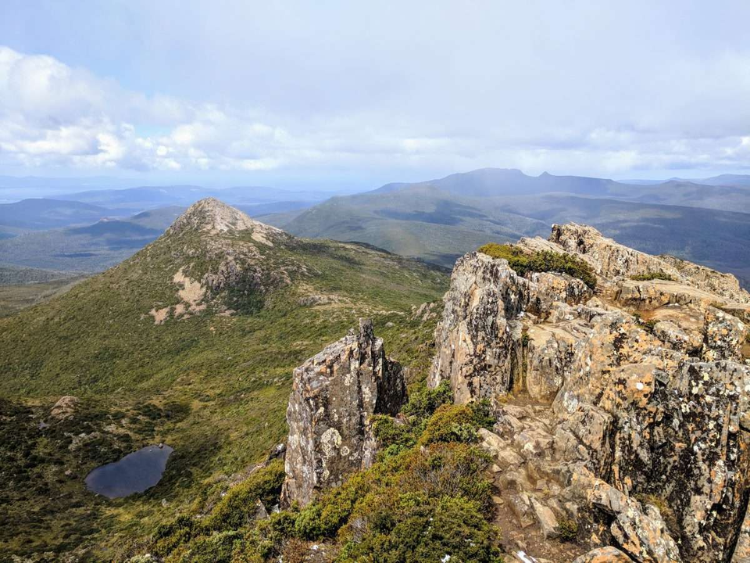
Hartz Mountains National Park is located in the southern region of Tasmania, Australia. It's situated approximately 84 kilometers (52 miles) southwest of Hobart, the capital city of Tasmania. The park is known for its stunning alpine landscapes, including rugged peaks, glacial lakes, and unique plant species.


Hartz Mountains National Park was established in 1939, making it one of Tasmania's oldest national parks. It was gazetted as a national park to protect its unique alpine environment and biodiversity.
Hartz Mountains National Park is renowned for its scenic beauty and diverse ecosystems. It encompasses an area of approximately 7,416 hectares (18,315 acres) and is characterized by its rugged peaks, including Hartz Peak, which stands at 1,255 meters (4,117 feet) above sea level.
The park features a variety of walking tracks that allow visitors to explore its natural wonders, such as the popular Hartz Peak Track, which offers stunning panoramic views of the surrounding landscapes. Additionally, the park is home to a range of wildlife, including native birds, wallabies, and pademelons.
Visitors to Hartz Mountains National Park can enjoy activities such as bushwalking, birdwatching, picnicking, and photography. The park is also a popular destination for camping, with several campsites available for overnight stays.
Overall, Hartz Mountains National Park is a must-visit destination for nature lovers and outdoor enthusiasts seeking to experience the beauty of Tasmania's wilderness.

Hartz Mountains National Park was not "invented" by a single individual. Rather, it was established through governmental action and conservation efforts. The park was gazetted as a national park by the Tasmanian government in 1939 with the aim of preserving its unique natural landscapes and biodiversity. The process of establishing national parks typically involves various stakeholders, including government agencies, environmental organizations, and local communities, working together to designate and protect areas of significant ecological or cultural value.


Hartz Mountains National Park derives its name from the prominent Hartz Mountains within its boundaries. The origin of the name "Hartz" is believed to be connected to the German word "Harz," which refers to a mountain range in northern Germany.
It's speculated that early European explorers or settlers in Tasmania may have named the area after the Harz Mountains in Germany, possibly due to similarities in landscape features or simply as a nod to their homeland.
The name "Hartz Mountains" has endured over time and became associated with the region, eventually leading to the designation of Hartz Mountains National Park when it was established to protect its natural beauty and ecological significance.




Hartz Mountains National Park is highly regarded by hiking enthusiasts for several reasons:
1. **Scenic Beauty:** The park boasts stunning alpine landscapes, including rugged peaks, glacial lakes, lush forests, and sweeping vistas. Hiking through such picturesque scenery offers a rewarding experience for nature lovers.
2. **Diverse Trails:** Hartz Mountains National Park offers a variety of hiking trails catering to different skill levels and preferences. Whether you're seeking a short, easy stroll or a challenging trek to summit a peak, there are options available for everyone.
3. **Hartz Peak:** The park's highest point, Hartz Peak, offers breathtaking panoramic views of the surrounding wilderness. Hiking to the summit of Hartz Peak is a popular choice for those seeking a challenging yet rewarding adventure.
4. **Wildlife Viewing:** While hiking in the park, visitors have the opportunity to encounter a diverse array of wildlife, including native birds, wallabies, pademelons, and possibly even echidnas or wombats. This adds an exciting element to the hiking experience.
5. **Tranquility and Solitude:** Despite its popularity, Hartz Mountains National Park retains a sense of tranquility and solitude, particularly on some of the less-traveled trails. Hikers can immerse themselves in the peacefulness of nature and escape the hustle and bustle of daily life.
6. **Accessibility:** Located relatively close to Hobart, the capital city of Tasmania, Hartz Mountains National Park is easily accessible for day trips or longer excursions. Its proximity to civilization makes it a convenient destination for hikers.
Overall, Hartz Mountains National Park offers a perfect blend of natural beauty, diverse trails, and opportunities for exploration, making it an ideal destination for hiking enthusiasts looking to connect with the great outdoors.






While Hartz Mountains National Park is indeed a fantastic hiking destination, the best time for hiking can depend on various factors such as weather, personal preferences, and trail conditions. Here's a breakdown of hiking conditions throughout the year:
1. **Spring (September to November):** Spring brings milder temperatures and blooming wildflowers, making it a delightful time to explore the park. However, trails may still be wet from winter rains, and snow may linger at higher elevations early in the season.
2. **Summer (December to February):** Summer offers warmer temperatures and longer daylight hours, providing ideal conditions for hiking. Trails are generally drier during this time, but it can also be the busiest season, especially during the holiday period.
3. **Autumn (March to May):** Autumn brings cooler temperatures and stunning foliage as the deciduous trees change color. Hiking during this season offers beautiful scenery and fewer crowds compared to summer.
4. **Winter (June to August):** Winter in Hartz Mountains National Park can be cold and wet, with the possibility of snowfall at higher elevations. While hiking during this season can be challenging due to slippery trails and limited daylight, it can also offer a unique experience for those seeking solitude and snowy landscapes.
Ultimately, the best time for hiking in Hartz Mountains National Park depends on individual preferences and desired trail conditions. Regardless of the season, it's essential to check weather forecasts, trail conditions, and park alerts before embarking on any hike to ensure a safe and enjoyable experience.